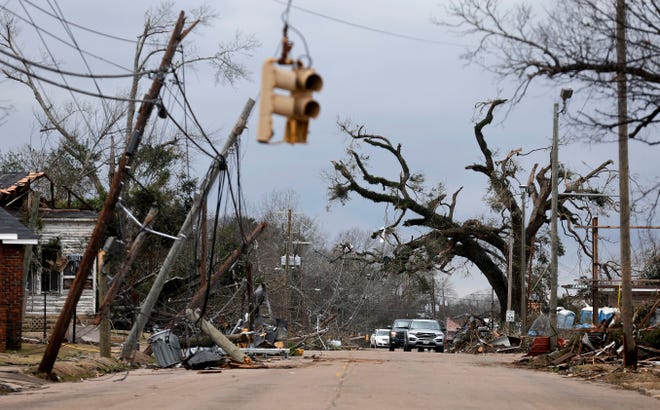SELMA, Ala. – As Pearlie Miller stood in front of her home in Selma, Alabama, on Friday morning, she wasn’t assessing the damage done by the destructive tornado that tore through the city the day prior.
An insurance adjuster had already done that for her — noting the entire left side of her house was blown in and the wrought iron posts on her porch were barely supporting the roof. After taking a direct hit from the tornado, the building wouldn’t be salvageable. She’d have to grab what she could and find somewhere else to stay.
Cold wind whipped around her, and as she looked on at the home she had lived in with her sisters, she wasn’t thinking about what was lost. She was thinking about her gratitude for her safety and that of her neighbors.
“It’s just God’s grace,” Miller said. “But Selma is alive.”
The city is famed for its historic sites: Pettus Bridge, where the Selma-to-Montgomery march is commemorated; Brown Chapel A.M.E. Church, where the Rev. Martin Luther King, Jr. and the Southern Christian Leadership Conference worked with local activists during the Selma movement; and the National Voting Rights Museum and Institute, founded in 1991 and opened near the bridge.
EXTREME WEATHER:Tornadoes are hitting more frequently and dealing more deaths in the South
The devastation in Selma stretches for miles in a diagonal path across the historic city. Several people sustained injuries, and at least one was serious enough to require transportation to a Birmingham, Alabama, hospital. Hundreds of homes and businesses have shattered windows and roofs in their front yards. Fallen trees and broken power lines hang over streets. At one point, 19,000 people in the area were without power.
Through all of the damage, though, Selma has reported no casualties. At least nine deaths have been reported across the rest of the state.
“The tornado came in and divided our city. It was a devastation,” Mayor James Perkins said in a news conference on Friday.
JOHN LEWIS:U.S. Postal Service to honor the civil rights icon with a 2023 postage stamp

Since the storm, the historic city garnered attention from across the country. American Red Cross set up a shelter in the local high school, members of the U.S. Congress offered help, and donations of time and cleanup efforts have poured in.
The tornado spared some major historic sites associated with King, like the Brown Chapel A.M.E. Church, which was the starting point for the Selma-to-Montgomery marches for voting rights. But it left some exterior damage on historic homes like Sturdivant Hall and Grace Hall.
“The historical nature of Selma, I believe, will put the eyes of the world on our disaster,” U.S. Rep. Terri Sewell told the Montgomery Advertiser. “Because of the name Selma, it’s helped us galvanize resources. I just want to make sure they’re being channeled in the proper way.”
Selma’s downtown district is the place from which the late Amelia Boynton Robinson, a Selma voting rights strategist and civil rights movement matriarch, convinced King to get involved in the movement, hoping he would help nationalize the voting rights struggle. It’s where the late Georgia congressman and voting rights icon John Lewis was beaten nearly to death by state troopers as he crossed the Pettus Bridge on March 7, 1965.
SEVEN DAYS OF 1961:It was the ‘deadliest place’ for Black people in the US. That didn’t stop these high school students from changing history

Some residents, though, wonder why the history of their city is being used to leverage help — why the people who lost their homes aren’t reason enough for others to care.
“Selma has a thriving history, but we’re in the present,” Miller said. “Yes, things can be lost, but we have archives where that history is preserved. Now we need to focus on our community, rebuilding and making sure everybody is OK. The historic part should just take a back seat.”
Standing in front of her home Friday morning, Miller turned to look at the homes of her across-the-street neighbors. One had a tree resting on top of it.
The woman who lived there, she said, was entirely dependent on the care of others. When the tree fell, crushing her house, the woman was not able to get out. Miller’s sisters were able to call for help, and their neighbor was removed from the house unscathed.
“At least everyone around here is safe,” Miller said. “We’ll just start anew.”

R.B. Hudson Middle School history teacher Calvin Marshall was also on Miller’s street Friday morning. Along with a group of his Omega Psi Phi fraternity brothers, he was walking through the neighborhood to help clear the masses of debris.
“We’ve seen a lot of storms, but this is the worst it’s ever been,” he said. “A lot of the neighborhoods will be truly messed up here for years.”
Marshall plans to volunteer with cleanup for as many days or weeks his community needs him.
As for the history in Selma, he said it’s everywhere.
“Martin Luther King, Malcolm X, so many important people were in this community. They lived with these people,” he said. “Everything is a landmark in Selma, and if that gets us help, then good.”
Contributing: Associated Press


